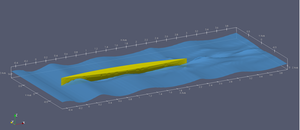Generating absorbing boundary conditions for waves and currents and wave interaction with ships at forward speed
 Background
Background
Waves propagate with currents in the open sea and both of them are understood to be of importance simultaneously. Waves travel large distances and because of the level of detail we wish to pursue in our simulations, these distances cannot be resolved within a single computational domain. For improved computational efficiency, artificial boundaries are introduced to truncate the domain to a size of one typical wave length around the structure of interest. Artificial boundaries cause spurious wave reflection if no special measures are taken to prevent it.
Main objective
To derive generating absorbing boundary conditions for minimal wave reflection in combined wave-current simulations in maritime applications.
First results
A numerical approach that addresses the objectve has been implemented in the CFD simulation tool ComFLOW. The absorbing boundary condition in the presence of a mean current includes an approximation of the dispersion relation which is accurate within a range of wave numbers. The advantage of this design is that the phase speed featured in the boundary condition, which is usually unknown due to dispersion, is now determined from the local flow solution in an implicit manner. The resulting boundary condition causes little spurious wave reflection for a range of wave components and currents.
The performance of the boundary conditions is assessed in a series of tests by observing the reflection coefficient. The capability of the boundary conditions to account for dispersive effects of waves on top of different mean currents is investigated. It was found that the boundary condition behaves as predicted with simplified theory. Another application of waves and current is that wave-ship interaction at forward speed can be investigated. Experimental tests with a scale model of Wigley hull at forward speed in waves were performed in the towing tank at Delft University of Technology. Heave and pitch motions of the Wigley hull were measured in the experiments and used as validation for the numerical results in ComFLOW to test our generating absorbing wave boundary conditions.
Participants
- Xing Chang
- Dr.Ir. Peter Wellens